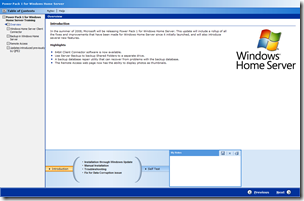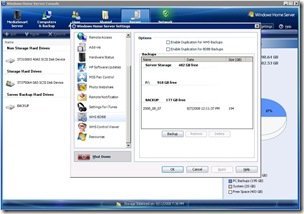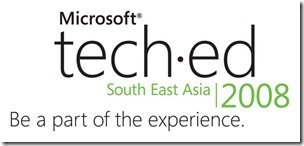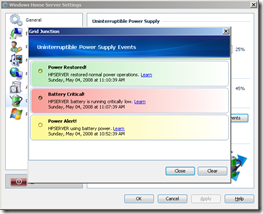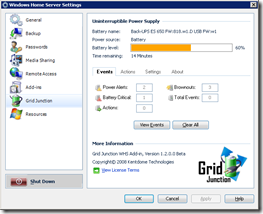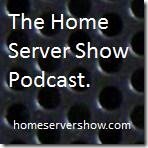Today as part of Patch Tuesday Microsoft released Power Pack 1 (PP1) on Windows Update and to coincide with this HP have published some guidance regarding how to best install and configure the HP MediaSmart Server with PP1 and the HP Software Update 1.3, as well as the optional add-ins. If you have Windows Update turned on, you will most likely receive Windows Home Server Power Pack 1 automatically.
Following these notes closely will ensure the best user experience for installing and configuring your updates.
If you already have the official Power Pack 1 update, then you do not need to do anything. There are no changes from the recent version which has already been posted at Microsoft’s Download Center.
To check if you have PP1, go into Console and click on Settings, then on Resources. If you have PP1, the version number will be listed as 6.0.1800.0. The Resources tab on the server will also be labeled Windows Home Server with Power Pack 1.
Microsoft’s Windows Home Server (WHS) PowerPack 1 is available on August 12 via the automated Windows Update distribution process. The Aug 12 release is the same WHS PowerPack 1 that has been available via download since July 21st With HP’s MediaSmart Server Software Update 1.3 also available, HP would like to offer MediaSmart Server (MSS) customers installation guidance for these upgrades so that you have a smooth and optimal installation experience.
HP is providing guidance for these 3 user scenarios:
1. PowerPack 1 installed, but no HP MediaSmart Server Software Update 1.3 or optional Add-ins installed.
2. HP MediaSmart Server Software Update1.3 installed, optional Add-ins installed, but WHS PowerPack 1 not installed.
3. A newly purchased HP MediaSmart Server w/ neither WHS PowerPack 1 nor HP MediaSmart Server Software Update 1.3 or optional Add-ins installed.
*Please note* It has been found that installing Windows Home Server PowerPack 1 and the two optional Add-ins from HP concurrently can utilize the majority of the resources on the Server during the install and initiation process. This may result in slow response times from the Server until each of these upgrades has completed their tasks. If you have installed other Add-ins or software packages that are active during the initial PowerPack 1 and MSS Software Update1.3 install and initiation processes on the Server, there may be an additional lag in response time. It has also been reported that the Windows Home Server Console can become unresponsive during this time. Once all applications have completed their tasks, the Server will return to normal operations.
Overview
WHS Power Pack 1 provides a range of new enhancements, including support for home computers running Windows Vista x64 editions, backup of home server Shared Folders, improvements to remote access, better performance and it delivers a fix for the Drive Extender bug. This is the same WHS PowerPack 1 that has been available via download since July 21st.
The HP MediaSmart Server Software Update1.3 will provide two optional Add-ins that you may choose to install: McAfee Server side anti-virus and Packet Video Connect media streaming. The Software Update will also fix some defects in the online guides, add several modifications to the HP Photo Webshare, improve Control Center performance and prepare the HP MediaSmart Server for Windows Vista 64-bit compatibility. Windows Vista 64-bit support does require users to install both WHS PowerPack 1 from Microsoft and MSS Software Update 1.3 from HP.
Upgrade Guidance – User Scenarios
1) If you have an HP MediaSmart Server, and you have installed WHS PowerPack 1, but have yet to install HP’s Software Update, HP recommends that you wait for PowerPack 1 to complete its operations. There is no indicator available to easily know when PowerPack 1 has finished. HP testing has shown that the more files you have on your Server, the longer it will take for PowerPack 1 to complete. However, the more hard disk drives you have installed on your Server, the time for PowerPack 1 to complete its processes does decrease.
For reference, HP testing shows that PowerPack 1 on a Server with 40GB, 100,000 files and 1 hard disk drive may take between 3 and 4 hours to finish. A Server with 40GB, 100,000 files and 3 hard disk drives may take between 1 and 1.5 hours to finish. A Server with 200GB, 100,000 files with 2 hard disk drives may take between 1 and 1.5 hours to finish. A Server with 750GB, 100,000 files with 3 hard disk drives may take between 1.5 and 2 hours to finish.
After PowerPack 1 has installed, the HP Software Update 1.3 is available by opening the WHS Console, navigating to the MediaSmart Server tab, looking below the HP MediaSmart software updates and clicking on “Check for updates.” This will install the HP Software Update and put the two optional Add-ins into the Add-in folder inside the Software folder on the MediaSmart Server.
HP recommends that the Add-ins are installed one at a time; install PacketVideo Connect first. Packet Video Connect will create a database of the media files on your Server. The database creation is not an intensive operation. HP testing shows that a Server with 40GB, 100,000 files may take approximately 1hour to 1.5 hours complete. A Server with 200GB, 100,000 files may take approximately 3 to 4 hours and a Server with 750GB, 100,000 files may take approximately 3 to 4 hours to complete. Then install the McAfee server side anti-virus. McAfee will need to index all the files on your Server and this process will take approximately 1 hour to complete.
2) If you have a MediaSmart Server, and you have installed HP’s Software Update, including the McAfee Add-in, HP recommends that you uninstall the McAfee Add-in before installing PowerPack 1. To uninstall, log on to the WHS Console, => Settings, => Add-ins, on the Installed tab, click “Uninstall” on the McAfee Add-in.
If you have Windows Update turned on, it is an automated process and you will most likely receive Windows Home Server PowerPack 1 during the 3:00 am to 6:00 am maintenance window. If you have a backup underway, PowerPack 1 will wait for the backup to finish before installing and performing its operations.
For reference, HP testing shows that PowerPack 1 on a Server with 40GB, 100,000 files and 1 hard disk drive may take between 3 and 4 hours to finish. A Server with 40GB, 100,000 files and 3 hard disk drives may take between 1 and 1.5 hours to finish. A Server with 200GB, 100,000 files with 2 hard disk drives may take between 1 and 1.5 hours to finish. A Server with 750GB, 100,000 files with 3 hard disk drives may take between 1.5 and 2 hours to finish.
If you do not have Windows Update turned on, you will need to go to your WHS Console => Settings, => General, on the right pane click on the “Update Now…” button. After PowerPack 1 installs, you will be asked to install the new Windows Home Server Connector on each PC that has access to your Server. A pop-up will show on the taskbar indicating a new Windows Home Server Connector is available. Log on to the Windows Home Server Console, click on the Network Health button on the
middle of the dark blue bar. On the Network Health drop-down box you will see a yellow highlighted notification asking you to install a new Windows Home Server Connector. Click on the link to install.
You can then re-install the optional McAfee server side anti-virus by logging on to the WHS Console, => Settings, => Add-ins, on the Available tab, click “Install” on the McAfee Add-in.
3) If you have a brand new HP MediaSmart Server, the HP Software Update 1.3 will be automatically installed during the initial set-up process; however the two optional MSS 1.3 Add-ins will be in the Add-in folder, but not installed. HP recommends that you first install Microsoft’s WHS PowerPack 1 before you complete these additional configuration tasks:
- Add any data to your Server
- Install the Windows Home Server Connector on other PCs on your network, or
- Install the optional McAfee and/or PacketVideo Connect.
Let PowerPack 1 complete its operations, and then add your data and install the optional Add-ins.
If you have Windows Update turned on, you will most likely receive Windows Home Server PowerPack 1 during the night. You can wait for this to happen or you can go and get PowerPack 1. Directions to get PowerPack 1 are in the next paragraph. If you have a backup underway, PowerPack 1 will wait for the backup to finish before installing and performing its operations.
If you do not have Windows Update turned on, you will need to go to your WHS Console => Settings, => General, on the right pane click on the “Update Now…” button. After PowerPack 1 installs, if you installed the WHS Connector on other PCs, you will be asked to install the new Windows Home Server Connector on each of those PCs. A pop-up will show on the taskbar indicating a new Windows Home Server Connector is available. Log on to the Windows Home Server Console, click on the Network Health button on the middle of the dark blue bar. On the Network Health drop-down box, you will see a yellow highlighted notification asking you to install a new Windows Home Server Connector. Click on the link to install.
HP recommends that you wait for PowerPack 1 to complete its operations. There is no indicator available to easily know when PowerPack 1 has finished. If you have already added files, HP testing has shown that the more files you have on your Server, the longer it will take for PowerPack 1 to complete. However, the more hard disk drives you have installed on your Server, the time for PowerPack 1 to complete its processes does decrease.
For reference, HP testing shows that PowerPack 1 on a Server with 40GB, 100,000 files and 1 hard disk drive may take between 3 and 4 hours to finish. A Server with 40GB, 100,000 files and 3 hard disk drives may take between 1 and 1.5 hours to finish. A Server with 200GB, 100,000 files with 2 hard disk drives may take between 1 and 1.5 hours to finish. A Server with 750GB, 100,000 files with 3 hard disk drives may take between 1.5 and 2 hours to finish.
After PowerPack 1 has installed, install the Windows Home Server Connector on each of the PCs that you want to connect to your Server. The next step will be to put all your files, such as photographs, videos, music or personal files on the Server.
HP recommends that the Add-ins are installed one at a time; install PacketVideo Connect first. Packet Video Connect will create a database of the media files on your Server. The database creation is not an intensive operation. HP testing shows that a Server with 40GB, 100,000 files may take approximately 1hour to 1.5 hours complete. A Server with 200GB, 100,000 files may take approximately 3 to 4 hours and a Server with 750GB, 118,000 files may take approximately 3 to 4 hours to complete. Then install the McAfee server side anti-virus. McAfee will need to index all the files on your Server and this process will take approximately 1 hour to complete.
